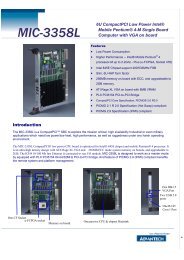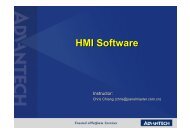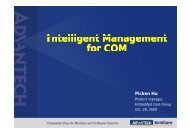industrial wireless book special edition - Networking ...
industrial wireless book special edition - Networking ...
industrial wireless book special edition - Networking ...
Create successful ePaper yourself
Turn your PDF publications into a flip-book with our unique Google optimized e-Paper software.
Fig. 6. IPv6 LoWPAN network example. Unlike the Cluster<br />
Tree method described in ZigBee, routes are only<br />
determined on an as-needed basis. This means that<br />
routes that are never used never get routing table entries<br />
and routes that are used frequently are continuously<br />
updated, thus optimising efficiency.<br />
method described in ZigBee, routes are only<br />
determined on an as needed basis. This means<br />
that routes that are never used never get<br />
routing table entries and routes that are used<br />
frequently are continuously updated, thus<br />
optimising efficiency.<br />
Strengths. Every node is a router with very<br />
low power consumption. Further, because every<br />
message is acknowledged and routes are<br />
determined on an as needed basis, the network<br />
is not overwhelmed with discovery traffic –<br />
important with sleeping battery powered<br />
routers. Efficient route discovery and routing<br />
means that the network only learns routes that<br />
actually get used (AODV). Frequency agility is<br />
supported and security involves both<br />
encryption and authentication. Reliability is<br />
projected at 99.99%. Finally, the system<br />
supports larger payloads with support for<br />
message fragmentation.<br />
Limitations. Efficient power management<br />
means long latency and non-determinism. Even<br />
though throughput is not limited by time slots,<br />
it is still limited depending on loading and<br />
discoveries. The network can scale to a<br />
moderate size of around 500+ nodes and can<br />
be very large if traffic is light and message flow<br />
doesn’t change much.<br />
System comparisons<br />
Using the criteria defined at the beginning of<br />
this document, they all do very well in security<br />
in that they have well defined encryption,<br />
authentication and authorisation schemes.<br />
ZigBee and 6LoWPAN have a slight advantage<br />
in that their key systems should be easier to<br />
implement and thus be more flexible.<br />
With respect to reliability, point to multipoint<br />
takes the biggest hit because it inherently has<br />
a single point of failure. Some schemes may<br />
have frequency agility options while others do<br />
not. Prior to the 2007 standard, ZigBee had a<br />
weakness in the frequency agility area which<br />
has now been fixed along with added support<br />
for message fragmentation. The others are<br />
similar – WirelessHART is designed to never<br />
lose a message while 6LoWPAN does well on<br />
the assumption that the existing TCP/IP<br />
protocol suite has class of service built in.<br />
While our own proprietary DigiMesh has a<br />
similar approach to WirelessHART, it is still<br />
somewhat unproven in large deployments.<br />
Power management will no doubt be hotly<br />
debated. WirelessHART defines systems where all<br />
nodes in the network, including routers, can<br />
sleep. Even though sleeping ZigBee end devices<br />
are most efficient when it comes to power, the<br />
fact that routers can’t sleep bumped the rating<br />
down. Until 6LoWPAN publishes a mesh and<br />
power management strategy, the rating will<br />
remain unknown.<br />
The scalability rating follows directly from<br />
the question of how big can the network get<br />
and still function. This is where the ZigBee<br />
2007 Pro stack shines. The Cluster Tree architecture<br />
creates a hierarchy which enables<br />
scalability. WirelessHART scales well; particularly<br />
if most communication is kept local –<br />
however, the networks can tend to get very<br />
slow when they become too large. Finally, point<br />
to multipoint architecture has an obvious<br />
limitation in the number of nodes that can be<br />
attached to one central point.<br />
The best data mover is no doubt the simplest<br />
system – namely point to multipoint. The<br />
simple network design means that focus can<br />
be made on short, deterministic latency and<br />
high data throughput. There is a direct trade<br />
off here with power. WirelessHART rates lower<br />
because it is focused on minimising power and<br />
maximising reliability – this naturally leads to<br />
less deterministic latency and lower<br />
throughput. Of course, as a network gets<br />
bigger, these two networks will actually do<br />
better. However, this is represented in the high<br />
scalability ratings for these networks. ZigBee<br />
fits in the middle because the backbone of<br />
powered routers can move data very efficiently<br />
– but can get stuck if too many route discoveries<br />
are needed.<br />
Cost may create the most debate. The ratings<br />
here were based primarily on the cost of<br />
available chip set solutions under the<br />
assumption that the right architecture is<br />
chosen for the right job. If not, then the cost<br />
ratings become meaningless. For example,<br />
attempting to deploy a ZigBee solution where<br />
battery powered routers are desired means<br />
infrastructure costs will skyrocket. So, given<br />
this caveat, point to multipoint, ZigBee and<br />
our DigiMesh protocol have common costs<br />
because they all use similar chipsets.<br />
Each <strong>wireless</strong> mesh architecture has its<br />
respective benefits and there is no single<br />
approach that fulfils every wish list. Hence, it<br />
is important to match the needs of the application<br />
to the capabilities of the network.<br />
Joel K. Young is senior VP and Chief Technology Officer,<br />
Digi International Inc.<br />
First published in the <strong>industrial</strong> ethernet <strong>book</strong> November<br />
2009<br />
sponsored by Advantech<br />
<strong>industrial</strong> ethernet <strong>book</strong>

















